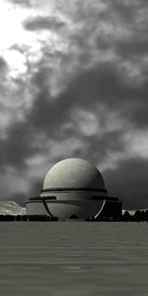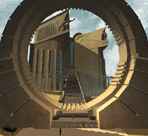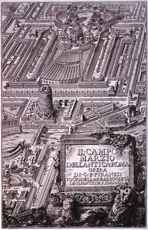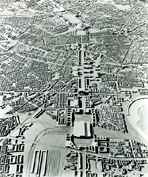
|
|
Sep. 3, 1996
|
Art Watch Index - Aug. 27, 1996
|
|
![]()
<<Archaeology of the Future City>>
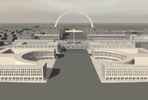
Giovanni Muzio, et al.
Etienne-Louis Boullee
Konstantin Melnikov
Giovanni Battista Piranesi
Albert Speer
|
<<Archaeology of the Future City >>
Archaeologizing the future city Leon Battista Alberti, Giovanni Battista Piranesi, Etienne-Louis Boullee, Claude-Nicolas Ledoux, Louis-Joseph Duc, Tony Garnier, Antonio Sant'Elia, Ivan Ilich Leonidov, Konstantin Melnikov, Jakov G. Chernichov, Ludwig Karl Hilberseimer, Frank Lloyd Wright, Albert Speer, Giuseppe Terragni, Archigram, Superstudio, Aldo Rossi. In this exhibition, we are able to see the architecture and urban projects that were developed by these artists but were not realized, through media such as prints, models, and CG animation. However, the title of the exhibition is not "The unrealized architecture and cities" nor "The history of the ideal city". It is <<Archaeology of the Future City>>. This mysterious and interesting title strongly communicates the intention of the exhibition. The future city depicting a model When we say "future city" we tend to think of the 21st century or one hundred years hence, but in this exhibition it is not important how many years ahead the projects were intended for. For example, the "Greater Berlin Plan" by Speer, sharing an important section in the display, was a project attempting to define the urban space under the Nazi German regime. Piranesi envisioned ancient Rome going back tens of centuries ago. Also, when we hear the words "future city" we often imagine a whole city or a science fiction film. However, here, single architectural projects such as those by the Russian Constructivists or Terragni, are exhibited as models and CG animation. Moreover, reconstructions of ancient Roman ruins and the Acropolis, which received the Grand Prix de Rome from the Ecole des Beaux-Arts, are also exhibited. One might think "why are these considered future cities?" Certainly, rather than "future cities", maybe it is more accurate to call them "ideal ciites". That is why the definition of the "future city" in this exhibition is "the ideal city as models which were not realized or which were almost realized". The issue now is the "model". Just as Piranesi and the Beaux-Arts pursued the model city in ancient Rome, as well as Nazi Germany in ancient Greece, the architects during the revolutionary period in geometry, and the Russian Constructivists in the industrialized society, even if they are not futuristic or megalomaniac, if a "model" is seen in them they could become the "future city". However, in terms of this exhibition tracing back the periods to indicate what kind of ideal cities were considered as models, it may not have been enough. The reason why the content of the exhibition was narrowed down was to illuminate the connection between the araheological imagination and the imagination for the future city. For example, Speer's plan under Nazi Germany and the EUR plan under Mussolini's Italy, or the survey of the ancient Roman ruins by the winner of the Grand Prix de Rome given by the Ecole des Beaux-Arts, were attempts to apply the ancient Greek and ancient Roman cities as models. Defining ancient Greece and ancient Rome as their roots is ideological, but was it not the archaeological imagination which made those realities? Rescuing the archaeological imagination by relativizing its relationship with ideology is one of the main objectives of this exhibition. That is also the reason for focusing on the context of the city under fascism. The highlight of the exhibition, the CG animation In terms of the exhibition content, as we approach the contemporary age, it seems the strength diminishes, and we can feel the frustration towards the contemporary creators who tend to resign from depicting the future city. Still, the CG animation production, which is the highlight of this exhibition, is considered a type of archaeology which depicts the total from comparing and considering fragmented information. It is a contemporary practice of showing that the archaeological imagination could lead to the creation of the future city. This exhibition does not directly indicate the contemporary vision of a future city. However, this exhibition itself, called the <<Archaeology of the Future City>>, is devised so that beyond these exhibited works, the practice of these ideas are discovered (wonderful!). We, on the other hand, are questioned how we become connected to the practice. I am thinking that maybe the entrance to the practice lies in the archaeology towards the environment of the contemporary city we confront today. [Yoshiharu Tsukamoto/Architect]
|
|
|
|
The <<Shiro Kuramata>> Exhibition
|
Transience, pathos and fragility
The fascination of Kuramata who nullifies the difference between genres and ideas This is a valuable exhibition which allows us to reconsider the works of Kuramata. Kuramata has been enjoying worldwide acclaim as well as high popularity in our country. This is apparent just seeing the list of interdisciplinary names in the executive committee of this exhibition such as Tadao Ando, Arata Isozaki, Kishin Shinoyama, Ikko Tanaka, Issei Miyake and Tadanori Yokoo. It is especially worthy of note to indicate that Ando and Isozaki, and Shinoyama and Araki (special exhibit) are included in the same list. From a different perspective, we could say that under the name of Kuramata, a group surpassing genres and ideologies have been united. I have mentioned above that the group has "surpassed ideologies", but surpassing ideologies itself already indicates an ideology. If so, we must question what composes Kuramata's appeal which is so strong as to nullify the difference between genres and ideas. The brilliant combination of Araki/Kuramata In terms of the above, the largest factor we must consider here is the usage of Nobuyoshi Araki's works in various spots among the hall plan. Since Ettore Sottsass worked on the hall plan, the idea of using Araki's photographs may have come from Sotsass. Whatever the reason, Kuramata and Araki, who may be considered an unusual pair, create a brilliant combination within the exhibition space. I recall that Kuramata has been evaluated in Japan for his internationality/global nature relating to Russian Constructivism and Modernism. When his works are exhibited along with Araki's, although they are based on Modernism, we recognize that a clear world which could, in some ways be described as an idiotic beauty, comprises his individuality. The clear ahistorical nature of the Japanese women photographed by Araki that indicates no rationality whatsoever, and the trace of the tight embrace resembling a rose that appears on the white skin as if it proves the former, becomes abstract through Kuramata's transparent transience typical of post-modern Japan which is similar to Japanese sweets using kudzu-kiri (transparent jelly), constructing a kind of Kawabata-like "Snow Country". I do not have the opportunity to refer to it in detail, but somewhere, the aesthetics supporting this exhibition seems to have a connection to a foreign nationalism that was necessary for post-modern Japan. However, I would hastily like to add that I am not criticizing this exhibition in my previous comment. I say so because I feel that those who do not feel the overpowering gravity, creating a vertigo-like sensation, from the world of Kuramata exhibited through three rooms on the second floor of the Hara Museum of Contemporary Art will not be able to feel the resistance towards the works they confront. [Noi Sawaragi/Art Critic]
|
|
|
|
|
|
|
|
|
Sep. 3, 1996
|
[home]/[Art Information]/[Column]
Copyright (c) Dai Nippon Printing Co., Ltd. 1996
Network Museum & Magazine Project / nmp@nt.cio.dnp.co.jp
